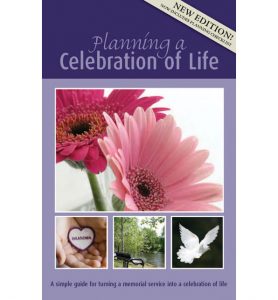Funeral Eulogies: 7 Steps
Give a funeral eulogy they will remember
Follow these steps and eulogy outline to prepare to give a memorial eulogy. We give several quick tips plus a step by step guide to writing and giving a funeral speech.
Quick tips for writing memorial speeches
– Write everything down so you don’t ramble, and try to keep the eulogy under 10 minutes
– Stay away from potentially embarrassing material (i.e. anything involving sex, drugs or troublesome in-laws)
– Share upbeat recollections; don’t add to the sorrow and weeping
– Don’t just talk about your relationship with the deceased; mention other friends and relatives
– Lastly, give a copy of the eulogy to someone else, who can take over if you break down
Step-by-step guide to writing a funeral eulogy
Step One: Gather information.
Jot down as many personal notes about the deceased as possible. Then look at photos. Flipping through photo albums may remind you of important qualities and memories of the person who died. Next, answer a few questions: What made your loved one truly happy? What inspired you to write this memorial speech? Think about what were your loved one’s passions? What will you remember most about this person?
Keep in mind that a eulogy is not a biography but more your personal thoughts and remembrances from your point of view. You may want to ask co-workers, friends and others for their stories and memories. After you start to see some repetition in your notes, this will lead to the main theme.
Step Two: Begin to organize your content.
Outline the eulogy in these steps:
I. A beginning to establish your theme.
II. A middle section to build on your theme with personal stories, information, quotes, comments, sayings, poems and other content. This information should make up 90% of the eulogy.
III. A short conclusion to summarize your thoughts and restate your theme.
Step Three: Next work first on the middle section (Part II).
Once you have this part the beginning and summary will be easy. Develop the outline by grouping similar themes from your notes from Step 1. For example, you might want to gather all the achievements together. Merge the comments about the deceased’s philosophy of life.
Step Four: Organize the conclusion (Part III).
A conclusion reminds the listeners of the theme and imprints the strong feeling you have about the loss. The key is to conclude effectively and quickly. Here is an example:
“We will all miss Jackie’s sense of humor, her talent for knowing what is really important in life and her famous chocolate chip cookies” (a little humor doesn’t hurt as long as it’s not offensive to anyone).
“Her example lives as an inspiration for all of us to follow.”
Have your guests fill out these memory cards to capture special memories of your loved one. These cards can be put in a pouch and taken out and shared at family gatherings for years to come.
Step Five: Write the beginning of the funeral eulogy (Part 1).
Memorial speeches usually start with an attention getter. It will set the theme and can be in the form of a short story, a poem, a saying, lyrics to a song. Also, it will introduce the goal and theme you used when you began the process.
Step Six: Polish it up.
Your best bet is to walk away from it for a few hours or overnight if possible. Then work on it so it sounds like a conversation. You want to talk to the audience as naturally as possible.
Key tips: Keep it short, 4-8 minutes long, 3-7 typed pages.
Type it out using 14 pt type so it’s easy to read.
Vary sentence length.
Number the pages.
Practice the eulogy aloud and time yourself.
Read it to friends and family and get their feedback. Edit where necessary.
Keep the content in good taste and keep it positive.
Step Seven: Delivering the funeral eulogy
While normally speakers do not read word-for-word, because you are more than likely going to be emotional, don’t be afraid to read word for word. This way you won’t leave out any key points you or others wanted said. If making eye contact with members of the audience will make you emotional, either try and keep your eyes on the page or look just over the top of the audience to the back of the room.
Feel free to pause, take a deep breath and drink some water. Everyone will understand. They are emotionally distraught also. Speak as naturally as you can just as if you were telling someone about your loved one. Also speak up. It’s very important that you speak clearly and loudly so that everyone can hear you. Keep the written speech as a memento. Later, you can add it to your memento chest and share it with others who may want a copy.
Summary
By following these steps, writing and delivering a funeral eulogy will become less stressful and more of a healing process. Knowing what to say at a memorial service is a matter of preparation and planning.
See two free sample eulogies: Sample eulogy from a reader who followed these steps, and now shares the funeral speech he wrote for a co-worker. Sample eulogy for a close friend.
Read Cher’s Eulogy for Sonny Bono.
Read a Eulogy for a best friend, written by Bob, one of the founders of www.nextgenmemorials.com
For more help, visit our Funeral Poems and Verses, Funeral Memorial Songs with lyrics and player, or Resource Index for planning a funeral.
Ideas you can use to create a unique Celebration of Life: (click photo for more info)
-

- Another idea for the person who liked to read, bring their favorite books to the service. Place them on or next to the memory table. Next to the books create a sign that says, “John was an avid reader. Please feel free to take one of his books and enjoy in his memory.”
-

- Planning a Life Celebration Downloadable Guidebook has many tips, ideas, and examples plus a handy checklist.
-

- This balloon idea has been very popular. Attach many photos or one from each year of your loved one’s life. Even if you don’t have dated photos, an approximation is good enough.















